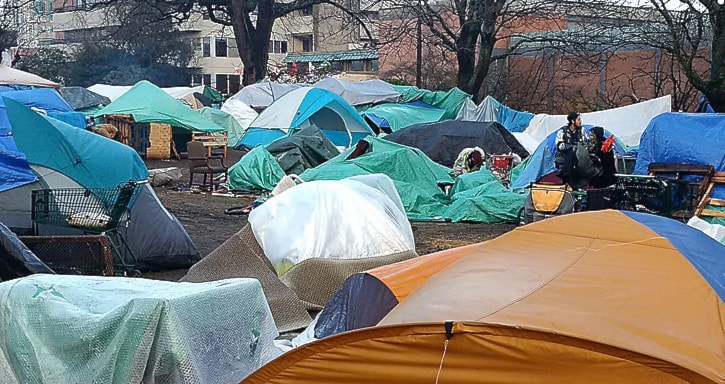Communities around B.C. are struggling to cope with the continued influx of what politicians call “homelessness,” a term that suggests the problem can be solved merely by providing more homes.
Taxpaying citizens see the daily reality behind the soothing euphemisms – mainly transients squatting in parks and “tent cities” blighted by drug abuse and crime, and “homeless” shelters that fill up as soon as they open. They worry that the continued costly supply of supports only invites more arrivals, particularly in the gentle climate of southwestern B.C.

Their worries are well founded. In Abbotsford, a 40-bed “temporary weather shelter” made from industrial camp trailers opened in December with a $450,000 operating grant from B.C. Housing.
It was full in 10 days. Abbotsford Police Chief Bob Rich told city council in January that his bike officers don’t recognize most of the shelter occupants from their constant patrols of local tent camps, the largest of which has been on a city-owned roadside site since 2013.
In Maple Ridge, a “low barrier harm reduction” shelter was opened last fall in response to a growing tent camp and accompanying drug dealing, prostitution and petty crime.
One resident noted bitterly that a mayor’s task force had identified 42 unsheltered homeless people, then found places for 77 from the camp, 40 from a closing “temporary” shelter and 40 in a new shelter. “How exactly does one house 157 out of 42?” she asked.
Victoria’s camping population has gathered in an Occupy-style squat on provincial land next to the courthouse, after years of uncontrolled camping in Beacon Hill and other city parks.
The city opened a shelter in a vacant Boys and Girls Club gym, complete with new indoor tents. By the time that was full, the courthouse camp was bigger than ever, with some occupants describing how they came to town for the opportunity. One said Vancouver Police gave her a bus ticket to Victoria.
The latest plan by a local agency that runs Victoria shelters is to convert an old, empty seniors’ care home into a 101-bed permanent housing facility. This would also be “low barrier,” a euphemism for allowing drug and alcohol consumption in the rooms.
The city has come up with around $1 million for this project, in a residential area next to a school, but it still needs millions more to renovate and run it. This would presumably come from B.C. taxpayers via our social housing czar, deputy premier Rich Coleman.
Coleman pioneered this “housing first” experiment in 2007, buying up 13 century-old “single-room occupancy” hotels in Vancouver’s notorious Downtown Eastside. These crumbling bedbug habitats were bought and renovated for a staggering $143 million, plus a 15-year maintenance commitment and a cop assigned to each one in an effort to contain the chaos inside.
Coleman brags endlessly about the great job he has done, but how is that actually working? A new study by Simon Fraser University researchers provides a more objective assessment.
Tracking 433 mentally ill homeless adults over 10 years, the study found the concentration of low-rent accommodation, food handouts, street outreach and medical supports resulted in “significant personal decline rather than recovery, as evidenced by their involvement in the criminal justice system, large increases in acute care and prolonged homelessness.”
The rate of people arriving in this service-intensive hellhole has tripled in the last 10 years, a finding similar to studies of concentrated services in New York, Sao Paulo and Osaka.
It’s a cautionary tale for other urban communities where this failed containment model is proposed.
Tom Fletcher is B.C. legislature reporter and columnist for Black Press. Email: tfletcher@blackpress.ca Twitter: @tomfletcherbc
